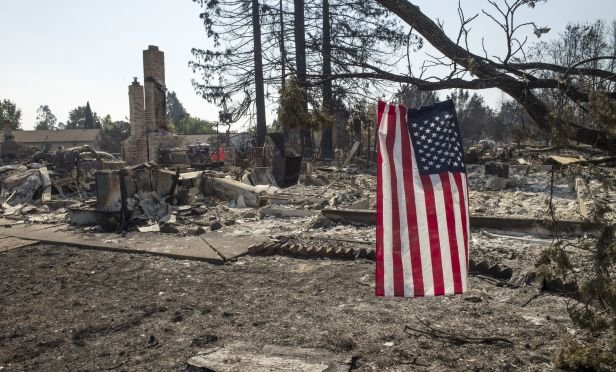 An American flag hangs from a tree in front of residences burned by wildfires in Santa Rosa, California, on Thursday, Oct. 12, 2017. Wildfires that tore through northern California's iconic wine-growing regions prompted evacuations of more than 20,000 people, killed 11 and damaged some of the most valuable vineyards and wineries in the U.S. About 1,500 commercial, residential and industrial structures were burned, and damage assessment teams have started accounting for the destruction. (Photo: David Paul Morris/Bloomberg)
An American flag hangs from a tree in front of residences burned by wildfires in Santa Rosa, California, on Thursday, Oct. 12, 2017. Wildfires that tore through northern California's iconic wine-growing regions prompted evacuations of more than 20,000 people, killed 11 and damaged some of the most valuable vineyards and wineries in the U.S. About 1,500 commercial, residential and industrial structures were burned, and damage assessment teams have started accounting for the destruction. (Photo: David Paul Morris/Bloomberg)
Updated 4:55 p.m. ET
Recommended For You
Want to continue reading?
Become a Free PropertyCasualty360 Digital Reader
Your access to unlimited PropertyCasualty360 content isn’t changing.
Once you are an ALM digital member, you’ll receive:
- Breaking insurance news and analysis, on-site and via our newsletters and custom alerts
- Weekly Insurance Speak podcast featuring exclusive interviews with industry leaders
- Educational webcasts, white papers, and ebooks from industry thought leaders
- Critical converage of the employee benefits and financial advisory markets on our other ALM sites, BenefitsPRO and ThinkAdvisor
Already have an account? Sign In Now
© Touchpoint Markets, All Rights Reserved. Request academic re-use from www.copyright.com. All other uses, submit a request to [email protected]. For more inforrmation visit Asset & Logo Licensing.







